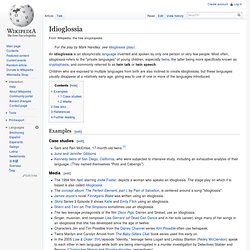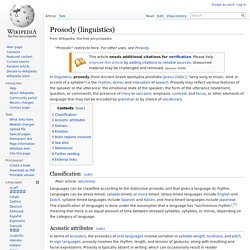

Idioglossia. An idioglossia is an idiosyncratic language invented and spoken by only one person or very few people.

Most often, idioglossia refers to the "private languages" of young children, especially twins, the latter being more specifically known as cryptophasia, and commonly referred to as twin talk or twin speech. Children who are exposed to multiple languages from birth are also inclined to create idioglossias, but these languages usually disappear at a relatively early age, giving way to use of one or more of the languages introduced. Examples[edit] Case studies[edit] Sam and Ren McEntee, 17-month-old twins.[1]June and Jennifer GibbonsKennedy twins of San Diego, California, who were subjected to intensive study, including an exhaustive analysis of their language. Definitions of Words for Love, Fondness and Preference. Definitions of Mania Words and Obsessions. Anaphora.
Syntactic ambiguity. Syntactic ambiguity arises not from the range of meanings of single words, but from the relationship between the words and clauses of a sentence, and the sentence structure implied thereby. When a reader can reasonably interpret the same sentence as having more than one possible structure, the text meets the definition of syntactic ambiguity. In legal disputes, courts may be asked to interpret the meaning of syntactic ambiguities in statutes or contracts.
In some instances, arguments asserting highly unlikely interpretations have been deemed frivolous. Different forms of syntactic ambiguity[edit] Globally ambiguous[edit] A globally ambiguous sentence is one that has at least two distinct interpretations. Locally ambiguous[edit] A locally ambiguous sentence is a sentence that contains an ambiguous phrase but has only one interpretation.
Prosody (linguistics) "Prosodic structure" is important in language contact and lexical borrowing.

For example, in Modern Hebrew, the XiXéX verb-template is much more productive than the XaXáX verb-template because in morphemic adaptations of non-Hebrew stems, the XiXéX verb-template is more likely to retain – in all conjugations throughout the tenses – the prosodic structure (e.g., the consonant clusters and the location of the vowels) of the stem.[2] Unique prosodic features have been noted in infant-directed speech (IDS) - also known as baby talk, child-directed speech (CDS), or motherese. Adults, especially caregivers, speaking to young children tend to imitate childlike speech by using higher and more variable pitch, as well as an exaggerated stress.
These prosodic characteristics are thought to assist children in acquiring phonemes, segmenting words, and recognizing phrasal boundaries. Prosody is useful for listeners as they perform sentence parsing. . ^ Jump up to: a b c d Fernández, E. Frugivore. Frugivore seed dispersal[edit] Seed dispersal is important for plants because it allows their progeny to move away from their parents in space and time.

The advantages of seed dispersal may have led to the evolution of fleshy fruits, which entice animals to eat the fruits and move the plants seeds from place to place. While many fruit producing plant species would not disperse far without frugivores, they can usually germinate even if they fall to the ground directly below the parent plant. Many types of animals are seed dispersers. Mammal and bird species represent the majority of seed dispersing species.
Plant adaptations to attract dispersers[edit] There are a number of fruit characteristics that seem to be adaptive characteristics to attract frugivores. Polymath. Leonardo da Vinci is regarded as a "Renaissance man" and is one of the most recognizable polymaths.

A polymath (Greek: πολυμαθής, polymathēs, "having learned much")[1] is a person whose expertise spans a significant number of different subject areas; such a person is known to draw on complex bodies of knowledge to solve specific problems. The term was first used in the seventeenth century but the related term, polyhistor, is an ancient term with similar meaning. The term applies to the gifted people of the Renaissance who sought to develop their abilities in all areas of knowledge as well as in physical development, social accomplishments, and the arts, in contrast to the vast majority of people of that age who were not well educated. This term entered the lexicon during the twentieth century and has now been applied to great thinkers living before and after the Renaissance.
Renaissance ideal[edit] Robert A. Related terms[edit] Quaintrelle. Sporty Parisian dandies of the 1830s: a tight corset helped one achieve his silhouette. The man on the left wears a frock, the man on the right wears a morning dress Though previous manifestations of the petit-maître (French for small master) and the Muscadin have been noted by John C. Prevost,[4] the modern practice of dandyism first appeared in the revolutionary 1790s, both in London and in Paris. The dandy cultivated skeptical reserve, yet to such extremes that the novelist George Meredith, himself no dandy, once defined "cynicism" as "intellectual dandyism"; nevertheless, the Scarlet Pimpernel is one of the great dandies of literature. Some took a more benign view; Thomas Carlyle in his book Sartor Resartus, wrote that a dandy was no more than "a clothes-wearing man".
Etymology[edit] Beau Brummell and early British dandyism[edit] In 1836 Thomas Carlyle wrote: